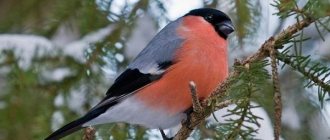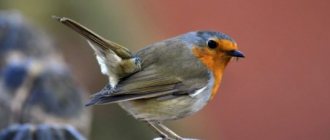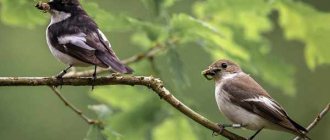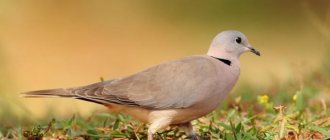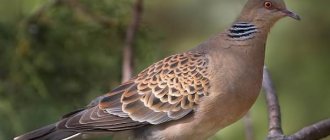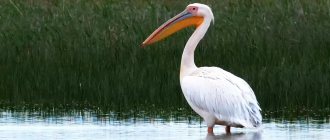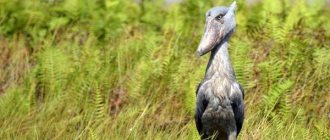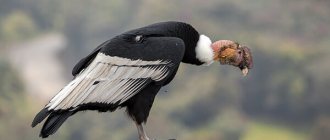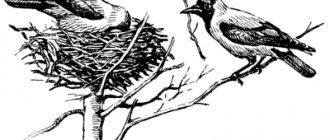- Wild animals
- >>
- Birds
The corncrake is a medium-sized bird that belongs to the order Craniformes and the rail subfamily. The international Latin name for the bird is “crex-crex”. Such an unusual name was given to the bird because of its specific cry. The corncrake was first classified in 1756 by Carl Linnaeus, but due to minor inaccuracies in the description, for some time it was believed that the bird belonged to the chicken family.
Description of the bird
— Advertising —
Female corncrake in rice meadows
The corncrake is a small bird that is similar in size and weight to a chicken. The color allowed it to adapt to the steppe environment, where the bird hides from hunters.
Why was it called that?
In the photo, the corncrake makes the sound: “crax-crax”
“Creke” in Russian probably has an onomatopoeic origin. The scientific Latin name is Crex crex. This term was introduced by biologist Carl Linnaeus in 1758, giving the bird a name consonant with the cries it makes. Another name – “twitch” – also appeared due to the interesting voice of the bird. When attracting a female, the corncrake makes “drr-drr” sounds and strongly stretches its neck.
Appearance
— Advertising —
Crake makes sounds in the grass
From the photo, the corncrake can be confused with small quails. But the twitch has its own physique characteristics:
- The corncrake has a dense body, slightly pressed from the sides.
- The head has a neat round shape.
- Curved, powerful short beak. It is colored pink, close to red.
- The eyes of young chickens are colored gray-brown, while in adults the brown color predominates.
- The long neck becomes wider closer to the body.
- The wings are small in size and have dense feathering. The spread reaches an average of 50 cm.
- The bird's legs are long and strong, which allows it to cover long distances on foot. They are painted ocher. Adult corncrakes have darker paws than young birds.
- The tail is short and straight.
The twitcher has dense motley plumage all over its body. The color of the feathers is dominated by brown and grayish shades, which allows the bird to remain unnoticed in dense thickets of tall grass. In the second half of summer, molting begins, as a result of which the bird loses its wing feathers, allowing it to take off.
Recognizable features that allow you to distinguish the corncrake from other related birds:
- the beak of the shepherd and crake is longer;
- the quail's beak is shorter;
- The color of the corncrake is lighter than that of European rails;
- The bird's voice is quite recognizable and unique.
The genus of corncrakes does not form subspecies and is divided into two species - African and common.
The size of the bird is small:
- weight – 80-200 g;
- body length – 25-30 cm;
- wingspan – 45-55 cm.
The color of the crake's plumage is variegated and is distinguished by an abundance of brown, red and gray shades. The sternum and sides of the head are colored bluish-gray, and the back is dark brown. The plumage on the abdomen and part of the neck is creamy and yellowish.
During the breeding season, gray spots appear on the upper body, which become lighter after the eggs are laid.
Taxonomy[edit | edit code]
The first scientific description of the corncrake appeared in 1758 in the 10th edition of the System of Nature by Carl Linnaeus. The author assigned it the Latin name Rallus crex
and placed it in the same group with the water rail, the colored snipe (
Rostratula benghalensis
) and the Carolina crake (
Porzana carolina
)[3].
In 1803, the German naturalist Johann Bechstein isolated it into a separate, at that time monotypic, genus Crex
and designated it
Crex pratensis
[4].
Later, due to the principle of naming priority in favor of early use, the species acquired the final name Crex crex
.
The closest relative of the corncrake is the African corncrake, which is currently also included in the genus Crex
[5].
The specific, as well as generic, name comes from ancient Greek. κρέξ - words that in the works of Herodotus, Aristophanes, Aristotle and other authors referred to a certain long-legged bird. Modern linguists suggest that the name is an imitation of the voice, which may refer to the corncrake, torukhtan or stilt[6].
The rail family, which includes corncrakes, includes about 150 species, most of which lead an aquatic or semi-aquatic lifestyle. Most birds of this family and its most primitive forms live in the tropics of the Old World, which speaks in favor of the theory of the origin and diversification of the family in this area. However, neither the available paleontological finds nor molecular data provide a clear answer to this question[7].
Behavior and diet
Crake hunts
Information about the behavior of corncrakes was first obtained from hunters. They noted that the bird rarely hovers in the air and reluctantly rises to heights, only if necessary. Birds fly clumsily and often hit poles. They do not rise high into the sky, but prefer to take small heights. During the flight, the bird looks shot - its back part hangs in the air, and its legs remain not tucked to the body.
Twitchers fly long distances only in early autumn, when their migration to the south begins. During this period, they behave more confidently, flapping their wings deeply in the air.
Crakes move mainly on long legs. They run fast and are excellent at avoiding obstacles.
The bird prefers to lead a secretive lifestyle and rarely catches the eye of humans. The corncrake hides in tall, dense thickets of grass and, in case of danger, quickly runs away on long strong legs. Despite its secretive lifestyle, the crake bird has been photographed many times.
What does it eat?
Crake in the grass
The food of corncrakes is quite varied. They love to feast on food of animal origin, as well as grass and berries.
Crakes feed on insects - beetles, dragonflies, grasshoppers, as well as earthworms and slugs. On rural lands, the twitch is considered a useful bird, as it destroys long-legged mosquitoes, click beetles and other pests. In African countries, the corncrake preys on cockroaches, termites and dung beetles.
The bird can be called a predator. Crakes prey on small frogs, tadpoles, fish and mice. However, the corncrake will not chase its prey if it does not catch it itself.
Dergach includes a variety of grains in its menu. It can feed on grass seeds - sunflower and flax. Sometimes a bird can treat itself to berries. If they hang high, the crake will not waste energy trying to reach and pick them. The bird will only eat what is at its growth level.
Crake lifestyle
The lifestyle of corncrakes partly depends on their species. Common birds love dry biotopes with tall grass. African corncrakes choose lower vegetation and wetter areas. In addition, representatives of the species are less secretive than ordinary birds. Other features of the life of the species are the same:
- all corncrakes fly reluctantly and clumsily, without tucking their legs in flight, which simply dangle in the air
- birds of the species are able to cover considerable distances on foot, which explains the development and muscularity of the birds’ legs
- Crake birds are active at night, resting during the day
- representatives of the species sing with their heads raised above the grass and often turning their necks, which makes it difficult to determine the location of the animal by its voice
- up to 300 times in a row the sound is heard, the corncrakes shout “crack-crack-crack”, which is similar to the “music” obtained by running a wooden stick along the teeth of a comb
- representatives of the species are loud-voiced, the cries of birds can be heard a kilometer away
- when frightened, the corncrakes chatter like magpies
- Running quickly through the grass, corncrakes are able to abruptly change direction without reducing their speed of movement
- all corncrakes are migratory, with common ones heading to Europe and Africa for the winter, and African ones moving across the mainland, escaping drought
- Corncrakes run, bending their necks to the ground, which allows them to get lost in the grass, but from time to time the birds have to raise their heads in order to survey the route
Common Crake
It is distinguished by corncrakes and a solitary lifestyle. Birds even go on long flights without accompanying persons. The route is designed so that frequent stops are possible. Otherwise, poorly flying corncrakes risk not arriving at their destination.
Habitats
Crake chick in a nest
Dergachi live everywhere in the vast expanses of the Eurasian continent. They usually live in flat areas, but sometimes nest in the mountains. In the vicinity of the Tien Shan, twitchers have been spotted at altitudes up to 3000 m above sea level.
Where is it distributed?
The corncrake stands on a stone.
The distribution area of the corncrake has sharply decreased in recent years. The birds live in Eurasia from Great Britain to China, but in fragments. The main factors in population decline are hunting activities and changes in natural landscapes as a result of human economic activity.
The bird can be found in Southern Europe, Russia, Norway, Switzerland, Kazakhstan and a number of other countries in Asia Minor and Central Asia. In Western Europe it is considered a rare bird, while in our country the number of corncrake is stable.
When winter comes in the middle zone, the corncrake moves to South Africa, where one of the two species of these birds permanently resides.
Landscape preferences
Crake photo
Crake prefers forest and steppe zones. It avoids open landscapes and hides in spacious meadows. Most often the bird can be found in thickets of iris and sedge. Sometimes birds appear in forest clearings, fields and highlands.
The jerk only avoids swamps, occasionally appearing in the upper reaches. The corncrake avoids open water and puddles, although it can swim.
The twitch nest is made in a dry, dark place. The depth of the dwelling reaches 40 mm, and the diameter is 150 mm. In the construction of corncrakes, stems of grasses and cereals, as well as pieces of moss, are used.
Migratory or wintering
Crake in nature
Crake is considered a migrant who leaves its inhabited habitat in cold weather. It makes flights at night. It is rare to see schools of corncrakes, as they move alone. Only in dangerous situations, when they are expected to fly over the mountains or the sea, do birds gather in small groups.
Where does it fly to for the winter?
Corncrake in flight
In August - late October, corncrakes fly to warmer climes, where more comfortable living conditions await them.
The bird prefers savannas in southeast and central Africa. In the northern regions of African countries, the songbird is less common. Especially many corncrakes can be found in the province of KwaZulu-Natal in South Africa.
The route of migratory birds passes through Morocco, Egypt and Algeria. They sometimes fly to the Azores, Canary Islands, Bermuda and Seychelles, and on rare occasions to the USA, Canada, Greenland and Australia.
Just before departure, the bird rapidly gains weight in order to survive the long journey. In Africa, the jerk also hides in grasses and shrubs with a height of 50 to 200 cm. Arrival in the European part occurs in the middle or end of spring, mainly in early May, when tall grass grows in the meadows and steppes.
Kinds
Corncrake photo in nature
All types of corncrake are characterized by the same preferences in food and place of residence. They are not attached to swamps and choose dense grasses with high humidity for nesting. There are two main known types of corncrakes - common and African. They have differences in color, size and habitat.
Common Crake
The cry of the corncrake photo
The common corncrake lives in European and Asian countries. It is nocturnal and has a timid character. The songbird avoids people. If threatened, he can flee to a safe place.
The plumage of the common corncrake is dominated by grayish-brown and rufous shades. The dimensions, compared to the second type, are slightly larger. A 30-centimeter bird can be compared to a quail.
The bird's numbers allow it to be beyond the threat of extinction, despite the fact that there are much fewer of them than representatives of the second species. Common African twitchers meet when they move for the winter.
African Crake (Crex egregia)
African corncrake (Crex egregia)
The second type of corncrake is common in African countries. The birds also belong to the rail species and their behavior is practically no different from the first species. They can often be found both in untouched forests and wet meadows, and near human habitations.
The color of the plumage of the African species is special. The beak and eyes are colored red, and black and brown spots predominate on the upper body. Most of the body is black and white, reminiscent of the stripes of a zebra.
Crex egregia is smaller in size. African corncrakes do not exceed 23 cm in length and are similar in weight to a starling.
Birds prefer to live in humid areas where it rains frequently. They live in the selected area almost the entire year, and then migrate in search of moisture.
The sounds that the African crake makes are similar to the cry of a crow. Unlike the common twitcher, another species leads an active life during the daytime.
CRAKE OBSERVATIONS
On beautiful May evenings you can hear a strange crackling sound from the meadows. This sound is heard with short breaks until late at night and from early morning until sunrise. The bird that makes this noise is a corncrake. This is a very shy bird, so it is more likely to be heard than seen. A suitable place to listen to corncrake is large swampy, but not too wet meadows not far from rivers and grain fields, where, in addition to tall and dense grass, shrubs also grow. A good way to attract corncrakes is to tape record their voices. Twitchers are especially active at night. They know how to hide not only in bushes, but also under sedge.
Female and male
Corncrake male photo
Externally, it is quite difficult to distinguish a female from a male, since the small birds are very similar. Heterogeneous representatives of the rail family still have several differences.
The main differences between a male and a female
Photo of a female corncrake in nature.
Sexual dimorphism in corncrakes is weakly expressed. It manifests itself literally in three main differences that are related to behavior and appearance.
Distinctive features of males from females:
- The males are slightly larger than the females, so the males look larger.
- The color of the crop in females is reddish, while males have a gray color in this area.
- Some differences were noted in the behavior of corncrakes of different sexes. Initially, it was assumed that only females were involved in nest construction, but later scientists found out that males also build nests. During the mating season, it is the male twitchers who look for territory for the female to lay eggs. They call birds with their territorial cry and reliably guard the occupied area. Moreover, males can occupy areas of up to 50 hectares, while females need 5.5 hectares for comfortable living.
Keeping at home and breeding
Corncrake chick photo
People often keep exotic animals as pets, so corncrakes were no exception. This bird does not like to live in captivity, but if the living conditions are comfortable, then it will feel calm.
How to keep it at home
How to keep corncrake at home
At home, corncrake is unpretentious to food, but requires care in organizing a home for it. He is afraid of loud sounds and bright lights, so when communicating with the bird you should speak quietly. A person needs to be patient so that the jerk becomes obedient and can adapt to new conditions.
It is not recommended to keep corncrakes in an apartment, as they require spacious housing. They will feel good in a suburban area if they are populated correctly. The process of moving into the enclosure should take place in the morning, so that in the light of day the bird can get to know its new home and owners. It is forbidden to relocate secretive birds at night, as they may panic and injure themselves.
A parrot or canary cage is not suitable for a corncrake. There should be plenty of space in the enclosure so that the bird can run around the area. It is recommended to place the pet's home outside in a place where the corncrake can hide from humans and other dangers. It is advisable to imitate thickets using reeds or other tall plants. Also, you should not combine several corncrakes in one cell, so that they do not start a war for territory.
What to feed
Feeding the corncrake photo
Feeding birds must be treated with care and caution so as not to frighten the animals or harm their health.
Crakes have a mixed diet, so the diet should consist of food of animal and plant origin. It is not possible to purchase specialized food for birds, since they are not sold in pet stores, but you can buy mineral mixtures with chalk.
Most jerks like sunflower and flax seeds, oats and millet. To maintain a balanced diet, you need to add fresh wild berries and fruits to your diet. It is recommended to feed the bird 2 times a week with animal food, for example, boiled eggs with shells, ant larvae, small insects and worms.
How does it reproduce
Female corncrake and chicks
It is not prohibited to breed twitchers at home, but it is important to follow the rules for caring for them and their home.
Females incubate eggs for approximately 2-3 weeks. On average, the corncrake lays from 7 to 14 eggs during one breeding period. The corncrake shell has a reddish color with a greenish tint and purple spots.
Chicks are born 16-20 days after laying eggs. Their initial color is quite dark and can reach black shades. Already on the second day, the babies leave the nest, but for another 3 days they cannot get their own food. At this time, the mother surrounds the offspring with care and protects them at all costs.
After just a few days, the birds become independent in terms of obtaining food. At the age of 35-40 days they begin to fly and turn into adult birds. Puberty occurs at the end of the first year of life. The appearance of the second brood occurs in the same year.
Reproduction[edit | edit code]
Mating season[edit | edit code]
Crakes with chick. Drawing by Johann Naumann, 1899
Puberty occurs at the end of the first year of life[40]. Males are the first to arrive at nesting sites. They behave silently for about a week, after which they begin to scream intensely, protecting the occupied territory from other males and calling females. Having noticed a potential partner, the male becomes silent, spreads his wings so that their edges touch the ground, extends and lowers his neck to the ground, spreads his tail feathers like a fan and spins around the female with muffled sounds, trying to attract her attention. A ceremonial offering of food is possible[40][18]. After mating, the vocal activity of the male decreases somewhat and becomes irregular. At the same time, the male does not wait for the brood, and with the end of laying eggs, he leaves his partner forever, moves to a new area and begins to display in a new circle, calling for a new female. On the other hand, a female also manages to breed two offspring in a season, successively mating with different males. Thus, the corncrake exhibits a mating system that is rare for rails—sequential polygamy[20][31].
The protected area of the male's territory varies from 3 to 51, on average about 15.7 hectares. The female feeds in a much smaller area—about 5.5 hectares[18]. At the border of areas, skirmishes between males are possible. When an intruder appears, the owner takes a threatening pose: spreads his wings, ruffles his feathers, stretches his head, and makes meowing sounds. In most cases, the intruder immediately retreats, but it happens that both birds mistake each other for an intruder and both take a warlike stance. In extreme excitement, the males rush at each other, try to knock each other down and peck. Females do not take part in territorial disputes and are never considered as intruders[41][18].
Nest[edit | edit code]
The nest is made in a dry place in a depression, usually in thick grass at the base of a sedge hummock, under the cover of a lonely tree, bush, or sometimes a fence. The nest building is small, but with a fairly deep tray: its diameter is 120-150 mm, height 70-80 mm, tray depth 35-40 mm[42][43]. Previously it was assumed that the nest was built exclusively by the female[29][22], but observations of the behavior of birds in captivity show that this is not entirely true. British ornithologists observed the behavior of corncrakes in the zoo for three years, creating conditions for them that were as close to natural as possible. Observations showed that the males independently built several nests for the choice of the female, and some of them were engaged in construction even before the female was allowed to approach him. A solid, well-built nest practically guaranteed subsequent mating[44]. Dry stalks of cereals, sedge, pieces of moss, and roots are used as building materials[42][16]. After the first brood, repeated laying is possible, often in a new, more elevated place, where the growing grass creates favorable conditions [2].
Incubation and chicks[edit | edit code]
Eggs from the collection of the Wiesbaden Museum
The total number of eggs laid at intervals of one egg per day varies from 5 to 14, in most finds no less than 7[16][20]. Very large clutches may indicate that the nest is being used by two birds. The shell is whitish-ochre or greenish in color with reddish-brown and purple spots of varying sizes. Egg dimensions are (33-42)x(25-29) mm[16]. The female sits on the nest for 16-19 days, after which all the chicks are born almost simultaneously[20]. They are initially covered with dark brown, almost black down and on the second day they leave the nest, while for another 2-3 days they are not able to obtain food on their own and are fed by the female. The ability to fly appears at the age of 34-38 days, but long before this time the chicks become completely independent and disperse [20]. In mid-July, when the first brood has broken up, the female begins the second clutch and spends more time with the new brood - about 15-20 days[32]. In July-August, birds begin a period of complete molting, during which they simultaneously lose their flight and tail feathers, and lose the ability to fly. From this time on, the corncrakes behave quietly and secretly[45][18]. Life expectancy is up to 5-7 years[46].
Interesting facts about the bird
Crake in the grass
The songbird, despite its inconspicuous appearance, has an original way of life. The behavior of corncrakes has been observed for more than 250 years. During this time, many interesting facts have accumulated about them:
- Twitch can swim well, but avoids open water. Chicks are even good at diving compared to adults.
- Skirmishes often occur at the boundaries of territories designated by males. Only male representatives take part in fights, since they do not consider the female a threat and do not perceive her as an intruder. When corncrakes see another bird in their area, they make sharp sounds similar to meowing.
- Relatives of the corncrake are the coot, moorhen, plume and rail.
- In July-August, twitchers lose the ability to fly. They shed, so they move only on their paws.
- Birds are able to imitate other voices, so you can often hear meowing, quacks, grunts and other sounds from them.
- The corncrake has almost no natural enemies, since the bird is very secretive, cautious and can run fast. But fights with other birds sometimes happen. The reason is the fact that the jerk is not averse to eating eggs.
Hunting for game birds is permitted, since the twitcher is not listed in the International Red Book.
Reproduction
For a long time, the Red Book considered the corncrake to be a vulnerable species, but gradually the situation began to improve, and new information about the population of this species appeared in Europe. This was facilitated by a significant change in the technology of hay collection, which previously caused the death of a significant number of clutches.
During the breeding season, corncrakes are significantly territorial, but they prefer to settle in small groups of several families, despite the large number of unoccupied territories.
Crake chick
At the same time, the males shout to each other, outlining the opportunity to protect their territory and family. Although the concept of family among twitchers is conditional, these birds are polygamous, both males and females. Those. are constantly looking for a new partner. That is why males court in their territory, and females calmly move around any territory, since they are not a threat. Well, after the breeding season, the boundaries are erased - and the males are able to move around calmly in search of food and shelter.
Singing + video
Crake sings photo
The corncrake bird has a characteristic voice. Despite their secretive lifestyle, people managed to record the singing of these birds.
Features of singing
Crake in the meadows
The corncrake's voice resembles the sounds of “drr-drr” or “kreks-kreks”. A crake's cry like this means that it is marking its territory. You can hear birds singing at a distance of 1.5 kilometers at night. In inclement weather, males sing during the day.
Depending on the situation, the bird's song may change. In case of danger, she chirps like a magpie. Females call young birds with high-pitched “oo-oo-oo” sounds, and sometimes a whistle, grunt or meow is heard from the corncrakes.
The voice of birds noticeably fades during autumn migrations. In winter they rarely sing and use their voice only in necessary situations.
